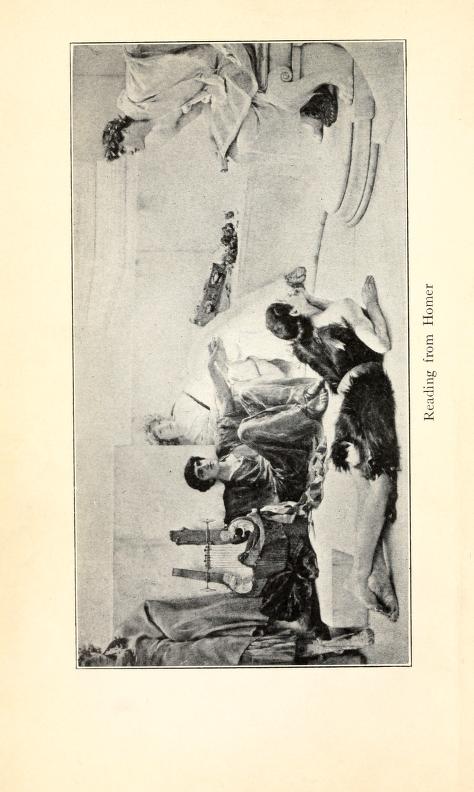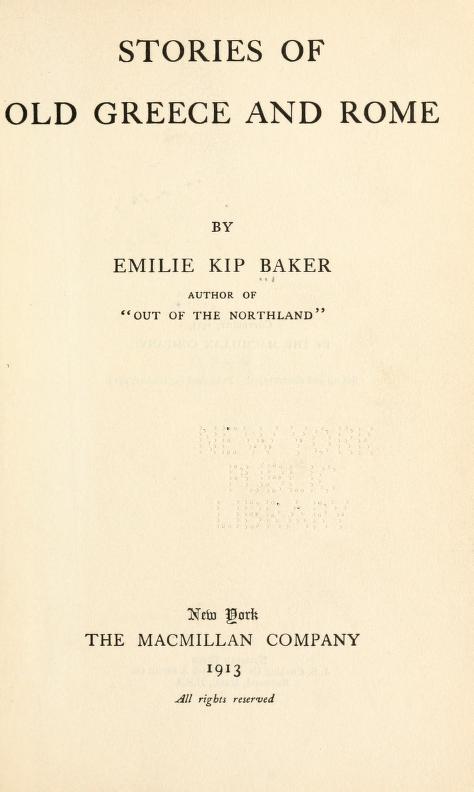Title of the work
Country of the First Edition
Country/countries of popularity
Original Language
First Edition Date
First Edition Details
Emilie Kip Baker, Stories of Old Greece and Rome. New York: The Macmillan Company, 1913, 294 pp.
ISBN
Available Onllne
Gutenberg.org (accessed: March 9, 2020).
Archive.org (accessed: April 4, 2023).
Genre
Fiction
Myths
Target Audience
Children (Middle or high school children)
Cover


Frontispiece and title page to Stories of Old Greece and Rome, retrieved from Archive.org, public domain (accessed: April 4, 2023).
Author of the Entry:
Robin Diver, University of Birmingham, robin.diver@hotmail.com
Peer-reviewer of the Entry:
Susan Deacy, University of Roehampton, s.deacy@roehampton.ac.uk
Lisa Maurice, Bar-Ilan University, lisa.maurice@biu.ac.il

Emilie Kip Baker
, 1873 - 1951
(Author)
Emilie Kip Baker was a children’s author of Macmillan books of poetry and myth, such as Out Of The Northland: Stories From The Northern Myths (1904) and The Children’s First Book of Poetry (1915). She was married to Franklin T. Baker, who founded the Columbia Teaching College’s Department of the Teaching of English.
Emilie Baker’s own works also show an educational interest; for example she published Short Stories and Selections for Use in the Secondary Schools (1916), which aimed to reintroduce works considered to be classics to children. In addition to short stories by authors such as Louisa Alcott and Charles Dickens, this work featured Nathaniel Hawthorne, Rudyard Kipling and Charles Lamb, all well known in the field of classical reception. This perhaps indicates possible influence from these authors on Baker’s classical work. In her introduction to Short Stories and Selections, Baker complained that nineteenth century classics were not given to children enough, and were forced to compete with modern publications. An open access copy of this book can be viewed here.
Sources:
Catalog of copyright entries: Books. Part, group 1, Volume 12, Issue 1; Librivox (accessed: December 16, 2019);
Goodreads (accessed: December 16, 2019).
Bio prepared by Robin Diver, University of Birmingham, RSD253@student.bham.ac.uk
Summary
This is an anthology for children which presents most of the best-known figures (human and divine) and stories from classical mythology. Famous artwork depicting mythological scenes lightly illustrates the chapters in places, but there is no original art in this book. In places, Baker quotes from famous poetry or English translations of classical texts, often translations by poets, in the middle of chapters.
- Chapter 1 In the Beginning (this introduces Mount Olympus and the story of Prometheus, not creation or the Titans).
- Chapter 2 The Story of Pandora.
- Chapter 3 The Deluge.
- Chapter 4 Minerva.
- Chapter 5 Apollo and King Admetus.
- Chapter 6 Apollo the Musician (Python, Marsyas, Midas).
- Chapter 7 The Love of Apollo (Clytie, Daphne, Phaeton).
- Chapter 8 Diana (Niobe, Actaeon, Orion).
- Chapter 9 The Story of Endymion.
- Chapter 10 Mercury (cattle theft, Io, Baucis and Philemon).
- Chapter 11 Venus (Callisto, Leda, Europa, affair with Mars, Adonis, Anchises).
- Chapter 12 The Story of Cupid and Psyche.
- Chapter 13 Famous Lovers (Echo and Narcissus, Pyramus and Thisbe, Hero and Leander, Pygmalion and Galatea).
- Chapter 14 The Story of Orpheus and Eurydice.
- Chapter 15 Mars and Vulcan (Ganymede, Romulus and Remus, Cadmus, Vulcan’s relations with family).
- Chapter 16 The Story of Proserpina.
- Chapter 17 Pluto and the Underworld (the Titans, the Fates, Coronis, Danaides, Tantalus, Salmoneus, Sisyphus).
- Chapter 18 Neptune and the Sea-Gods (Amphitrite, Arion, Aristaeus, Glaucus, Leucothea, Marpessa).
- Chapter 19 Bacchus (Semele, Pentheus, Midas).
- Chapter 20 Pan and the Nymphs (Syrinx, Dryope, Erysichthon, Rhoecus).
- Chapter 21 The Vestals (Aeneas, Lara).
- Chapter 22 Minor Deities (Aeolus, Janus, Iris and Aurora, Flora, Vertumnus and Pomona).
- Chapter 23 Hercules Part 1 (birth, labours).
- Chapter 24 Hercules Part 2 (golden apples, Alcestis, Omphale, Deianeira).
- Chapter 25 Perseus.
- Chapter 26 Bellerophon.
- Chapter 27 The Story of Jason Part 1 (family, Phryxus, Hylas, Phineus).
- Chapter 28 The Story of Jason Part 2 (clashing rocks, Medea, Medea’s killing of children).
- Chapter 29 The Calydonian Hunt (also the ending to Atalanta’s story).
- Chapter 30 Theseus Part 1 (parents, bandits, Medea, background to Minotaur).
- Chapter 31 Theseus Part 2 (Ariadne, Pirithous, abductions of Helen and Prosperina, Phaedra, death).
- Chapter 32 Oedipus (covers all the Theban tragedies).
- Chapter 33 The Apple of Discord (Peleus and Thetis, judgement of Paris, brief mention of Trojan war, then death of Oenone).
- Appendix (additional information, modern poetry and references).
Analysis
This is a long and detailed anthology which aims to include as many different myths as possible. The harsh nature of mythology and cruelty of the gods is preserved to a greater degree than in other children’s anthologies of the early twentieth century (compare, for example, Blanche Winder 1923 Once Upon a Time or Margaret Evans Price 1924 A Child’s Book of Myths and Enchantment Tales). The justice of the gods is allowed to be harsh, and classical heroes are often criticised by the narrative. Jason is criticised for his treatmrnt of Medea and Theseus for his treatmrnt of Ariadne; Baker also excuses the fact the Athenians eventually drive out Theseus by calling him ‘stern and tyrannical’ in his old age (p.238). At the same time, Baker displays a curious tendency to depict kings as good and kind, even when they are not usually shown to be so, particularly Acrisius and Aeetes; Aegeus and Laius are also presented in ways that excuse some of their more questionable actions. Acrisius is ‘a kindly ruler who dearly loved his only daughter Danae’ (p.187), even though he still imprisons her and then throws her out to sea in this version. Aeetes ‘treated the Argonauts kindly’ (p.214) and is honest and open about the difficulty of the task he sets to win the fleece, but is betrayed by his daughter and is presented as greatly grieving his son’s cruel death. Aegeus is a kindly and loving father who is not complicit in Medea’s schemes against Theseus. Laius’ fight with Oedipus on the road is blamed on an overly aggressive servant who Oedipus kills; Laius only attacks Oedipus upon seeing his servant killed.
In spite of the less than perfect portrayal of the gods, however, Baker diverges significantly from Ovid in her insistence that anyone who challenges the gods is necessarily greatly inferior. In stark contrast to Metamorphoses, Baker depicts Arachne’s belief she is Minerva’s equal as ridiculous, and when the two compete, ‘one glance [at Minerva’s loom] was enough to assure her [Arachne] of her own failure’ (p.23). Marsyas, meanwhile, does play beautifully, but Apollo defeats him not by cheating but by singing in addition to playing music. After Apollo has sung, ‘there was no longer any doubt to whom the victory belonged’ (p.35). Pan, meanwhile, does not want to challenge Apollo to a music contest at all, because he knows that he is inferior, but is forced to by Midas.
Elsewhere, however, Baker preserves Ovid’s narrative where other children’s anthologies do not. For example, the sexual innuendo of Echo and Narcissus’ verbal exchange is carried over: ‘“Come!” cried the youth, and Echo answered, “Come.” Then she appeared … but Narcissus scornfully turned from her, exclaiming, “You shall never have me.” “Have me,” cried the unhappy maiden’ (p.82). In general, Baker does not conceal sexual content as carefully as do other authors of this time period (e.g. Grace Kupfer 1897 Stories of Long Ago in a New Dress; Margaret Evans Price 1924 A Child’s Book of Myths and Enchantment Tales; Blanche Winder 1923 Once Upon a Time), possibly because this seems to be a more factual anthology aimed at older children. When Venus and Mars meet "in some lover’s bower’, they are seen by Apollo, who tells Vulcan ‘how much his wife was enjoying the society of Mars’. Vulcan then throws a net of linked steel over the two whilst they are ‘still conversing together" (p. 67). Thus Baker makes limited, and fairly transparent, attempts to tone down sexual scenes.
The mythological theme of virginity is treated frequently, often in ways that diverge from ancient sources. For example, Diana is not truly a virgin goddess in this version, since she occupies the role of Selene in the story of Endymion, making her Endymion’s lover. Baker includes the inaccurate assertion that the Vestal Virgins were undesirable for marriage after they completed their service and became technically free to marry: "so holy were the Virgins thought to become through their long residence in the temple, that it was held as a sort of sacrilege for any man to marry them [after their service]" (p. 156). This presumably represents an attempt to reconcile Christian and Roman ideas of virgin office. Baker also adds an aggressive jealousy felt by Juno towards Minerva that holds the curious implication Juno feels replaced in Jupiter’s eyes. "So wise did the Ruler of the gods find this child of his to be, that he kept her constantly near him, and sought her counsel in dealing with the affairs of men, while Juno, his stately wife, stood jealously by, envying the warrior-maiden her place at Jupiter’s side" (p. 21). Juno gets her own back by taunting Minerva with "her unwomanly fondness for warfare" (p. 22).
Baker seems to want all gods to be the god of something specific. She accordingly makes Maia goddess of the plains and Latona goddess of dark nights.
As in many other children’s anthologies of the modern period (e.g. the D’Aulaires’ D’Aulaires’ Book of Greek Myths 1962; Geraldine McCaughrean The Orchard Book of Greek Myths 1992), Echo’s story takes on a message about silence vs. speech it did not really contain in Ovid. Whilst in Ovid Echo was a genuinely charming speaker who others liked to hear talk, here "she had the one fault of wanting to talk all the time, especially if she found someone who was willing to listen" (p. 81). Talking is a ‘fault’ now in Echo, and the part about finding someone willing to listen implies this is a rare occurrence – most people would not want to hear Echo "talk all the time". There is thus an implied moral message about the beauty of silence, perhaps particularly for girls.
Finally, Baker includes a lengthy Appendix at the end of her book in which she lists translations, additional information and relevant English language poetry that deals with myth (e.g. Alfred Tennyson, Ben Jonson). In addition to reflecting Baker’s evident pedagogical interest, this is useful for the researcher in that we learn what some of Baker’s sources were, and what translations she used. Whilst most of her listed sources are those that would have been considered highbrow and academically reputable, at least at the time, in one place she refers the reader to Nathaniel Hawthorne’s very different children’s retelling of the Pandora story as a source: "There is a full account of Pandora in Hawthorne’s Wonder Book" (p. 257).
It is also clear from this Appendix that Baker, like many mythographers of the early twentieth century, was a believer in the theory of all myth as derived from a common source espoused by James Frazer and others. She writes that an alternative version of the Deucalion and Pyrrha story where they took refuge in an ark "shows more plainly the common source from which all these myths are derived" (p. 257). The Appendix also adds the uncomfortable to modern eyes sentence: "Cassiopeia was said to have been an Ethiopian; and was, therefore, in spite of her boasted beauty black" (p. 289). Baker dwells at length on the badness of Cassiopeia’s vanity and pride and the need to teach her humility.
The open access Project Gutenberg edition of this text also includes an index of names and footnotes referring the reader to the relevant part of the Appendix at the end. However, my paperback Leopold Classic Library edition (2015) has left these off, presumably accidentally since the footnote numbers still appear in the main text.


